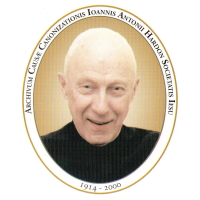Biography
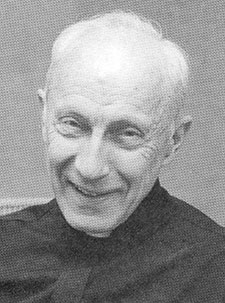 Prepared by Dr. Elizabeth Mitchell
Prepared by Dr. Elizabeth Mitchell
John Anthony Hardon was born on June 18, 1914 in Midland, Pennsylvania, USA, into a devout Catholic family. When Hardon was just one year old, his father John, aged 27 years, died in an accident. He was killed instantly by falling from a scaffold on which he was standing to perform an act of charity for a co-worker. Hardon’s mother Anna (Jevin), aged 26 years, supported the family by working as a cleaning woman, working nights in order to supplement the small recompense she received for her husband’s death. Hardon’s mother maintained this work throughout her life, and never remarried, out of concern for the influence a possible stepfather might have on her son’s vocation.
<< Get a free Fr. Hardon Prayer Card >>
Hardon’s childhood was happy and devout. His mother attended daily Mass and received Holy Communion throughout her life. His childhood home had sacred pictures, a family holy water font, and a good deal of spiritual conversation. Hardon’s mother took in two female Lutheran boarders to supplement the family income. Both boarders had a very positive relationship with the family, and attended Father Hardon’s first Mass after his ordination. John Anthony received the sacrament of Holy Communion at age six. Hardon commented on this event, and its impact upon his vocation, in his Spiritual Autobiography:
The most noticeable event of my childhood was my reception of First Holy Communion at the age of six. Sr. Benedicta, a member of the Sisters of Notre Dame who prepared us for our first Holy Communion, told us, “Whatever you ask Our Lord on your First Communion day, you will receive.” When I returned to my pew after Communion, I immediately asked our Lord, “Make me a priest.” I had only the faintest idea what I was saying, but I never forgot what sister had told us to do. When I was ordained twenty-six years later, my first sentiment was to thank Our Lord for hearing my prayers[1].
Hardon received the sacrament of Confirmation at the age of eight, asking on this occasion for the Holy Spirit to give him “the grace of martyrdom.”[2] As he commented in his Spiritual Autobiography about this mysterious grace:
Over the years, I should never forget the mysterious ways that our Lord has given me the privilege of professing my faith at no matter what price to my preference. Over the years, I have never tired telling people that Confirmation prepares them to live a martyr’s life, if it is God’s will to die a martyr’s death.[3]
John Anthony began his grammar school education at St. Wendelin School in Cleveland, Ohio, walking two miles each way from home to school and back. After his third year in grammar school, Hardon and his mother moved to St. Michael’s Parish. Hardon excelled in academics, and consistently placed at the top of his class. It was also during these days of Catholic grammar school that Hardon formed his intention to become a priest. 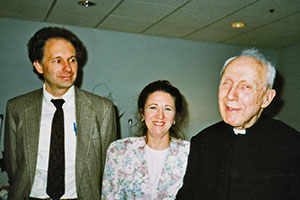 In his high school years, Hardon applied and was admitted to Cathedral Latin, a Catholic high school located 15 miles from his home. Taught by the Brothers of Mary, Hardon was confirmed in his Catholic faith during these years. Hardon studied the role of the Bishop of Rome as Vicar of Christ, a subject which laid the groundwork for his future doctoral dissertation. He also fostered a devotion to the Blessed Mother, and the traditions of opening and closing each class with a prayer, a tradition which he continued throughout his own teaching career.
In his high school years, Hardon applied and was admitted to Cathedral Latin, a Catholic high school located 15 miles from his home. Taught by the Brothers of Mary, Hardon was confirmed in his Catholic faith during these years. Hardon studied the role of the Bishop of Rome as Vicar of Christ, a subject which laid the groundwork for his future doctoral dissertation. He also fostered a devotion to the Blessed Mother, and the traditions of opening and closing each class with a prayer, a tradition which he continued throughout his own teaching career.
As Hardon completed high school, the thought of a priestly vocation continued to grow. Unwilling to leave his widowed mother alone, however, Hardon decided against the seminary directly after high school. With the help of savings his mother had put aside specifically for his future, Hardon enrolled in John Carroll University. He rode the streetcar to and from school each day, a distance of three to four hours daily. The distance, and his mother’s financial sacrifice to send him to University, brought Hardon to appreciate both his faith and education at a much deeper level. In his first two years at John Carroll University, Hardon pursued studies in science, with the intention of becoming a medical doctor. However under the guidance of his priestly advisor, Hardon began, in his third year of studies, to discern more clearly his own call to the priesthood. As he moved interiorly toward a priestly vocation, Hardon changed his course of studies to include Latin, philosophy, and college theology.
Hardon was instinctively attracted to the religious life, through the example of his Jesuit teachers, and began reading the lives of St. Ignatius of Loyola, St. Francis Xavier, and St. Aloysius Gonzaga. Both the academic rigor of the Society of Jesus, and their special fidelity to the Holy Father, attracted Hardon to the Jesuits. It was in his senior year that Hardon also weighed the possibility of becoming engaged to a grammar school friend, with whom he had kept in contact throughout his college years. While the young lady was bright, friendly, and faith-filled, Hardon decided that his calling was to the priesthood in the Society of Jesus. He broke the news to her at dinner on Sunday evening before entering the novitiate. Her tears at this news, however, did not deter Hardon in his vocation and the young lady went on to become happily married with a family and several children.
With his mother’s blessing, Hardon was now free to follow his priestly vocation. He obtained his Bachelor of Arts degree from John Carroll University in 1936, and entered the Jesuit novitiate that same year. He later commented about his vocational decision, “Over the years since that decision, with God’s grace, I had never once doubted that what I was doing was consistent with the Divine Will. … A vocation to the priesthood is a special call from God that nothing, and I mean nothing, should raise a doubt whether to answer the call or not.”[4] On the eighth day after his entrance into the novitiate, Hardon’s acceptance to the Order was confirmed by the tradition of finding a Jesuit cassock on his bed for him to wear. In his enthusiasm about being accepted into the Order, Hardon spontaneously kissed the cassock. He continued this tradition everyday throughout his priestly life. During his formative years with the Jesuits, he obtained a Master’s degree in philosophy at Loyola University in Chicago in 1941. He was ordained to the priesthood on June 18, 1947, his thirty-third birthday. Reflecting on the grace of his ordination and the pastoral mission which lay ahead, Hardon writes,
After being ordained to the priesthood in 1947, I still had several years of preparation for my final ministry. Unexpectedly, I was told that my vocation would be to prepare men to train priests. Never in my wildest dreams did I anticipate what this would mean. It would mean long preparation in understanding the Catholic faith, and I mean understanding the Catholic faith. Not only that, but the price that had to be paid in defending what had become the most trying century of Catholic Christianity.[5]
After his ordination, Fr. Hardon was sent for two years of special doctoral studies in theology to the Pontifical Gregorian University in Rome. Hardon was appointed director of the graduate library as well. He suffered greatly when asked by his superior to personally retrieve all of the heretical volumes which had been borrowed by graduate students. Hardon writes, “Before I had retrieved one-half of the heretical books, I had become the agent of orthodoxy and therefore the sworn enemy of the modernists, who were updating the Catholic faith to its modernist theology. I had doors slammed in my face. I lost friends whom I had considered believers,”[6] he grieved. He further comments:
The lessons I learned were invaluable. … It taught me that the faith I had so casually learned could be preserved only by the price of a living martyrdom. This faith, I was to find out, is a precious treasure that cannot be preserved except at a heavy price. The price is nothing less than to confess what so many others either openly or covertly denied.[7]
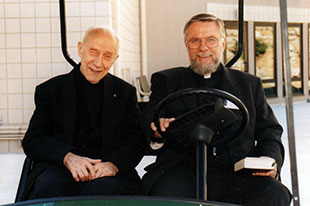 Father Hardon received his Doctorate in Sacred Theology (S.T.D.) from the Gregorian University in 1951, with a dissertation entitled, A Comparative Study of Bellarmine’s Doctrine on the Relation of Sincere Non-Catholics to the Catholic Church. He later commented, “I could not have chosen a better subject in preparation for a lifetime of teaching Catholic doctrine.”[8] He pronounced his final vows in the Society of Jesus on February 2, 1953, the Feast of the Presentation of the Lord. Fr. Hardon then began an illustrious teaching career, spanning both centuries and continents. He served as an associate professor of Fundamental Theology at West Baden College, Indiana, from 1951-62, and as an associate professor of Religion at Western Michigan University from 1962-67. Hardon was then sent to teach as a professor of Fundamental Theology at Bellarmine School of Theology, in North Aurora, Illinois, and Chicago from 1968-73. In 1973, he became a research professor at the Jesuit School of Theology in North Aurora. From 1974-88, he taught as a professor of Advanced Studies in Catholic doctrine at St. John’s University in Jamaica, New York, and served as a visiting professor of Comparative Religion at St. Paul University, in Ottawa, Canada, from 1968-74. Fr. Hardon also taught as professor at the Notre Dame Institute, a Pontifical catechetical institute, in Virginia, from 1981-90.
Father Hardon received his Doctorate in Sacred Theology (S.T.D.) from the Gregorian University in 1951, with a dissertation entitled, A Comparative Study of Bellarmine’s Doctrine on the Relation of Sincere Non-Catholics to the Catholic Church. He later commented, “I could not have chosen a better subject in preparation for a lifetime of teaching Catholic doctrine.”[8] He pronounced his final vows in the Society of Jesus on February 2, 1953, the Feast of the Presentation of the Lord. Fr. Hardon then began an illustrious teaching career, spanning both centuries and continents. He served as an associate professor of Fundamental Theology at West Baden College, Indiana, from 1951-62, and as an associate professor of Religion at Western Michigan University from 1962-67. Hardon was then sent to teach as a professor of Fundamental Theology at Bellarmine School of Theology, in North Aurora, Illinois, and Chicago from 1968-73. In 1973, he became a research professor at the Jesuit School of Theology in North Aurora. From 1974-88, he taught as a professor of Advanced Studies in Catholic doctrine at St. John’s University in Jamaica, New York, and served as a visiting professor of Comparative Religion at St. Paul University, in Ottawa, Canada, from 1968-74. Fr. Hardon also taught as professor at the Notre Dame Institute, a Pontifical catechetical institute, in Virginia, from 1981-90.
<< Go to a list of apostolates founded by Fr. Hardon >>
In all of these years, Fr. Hardon never wavered in his orthodoxy and loyalty to the teaching of the Magisterium. As he noted about his teaching years in his Spiritual Autobiography:
All these years of remaining faithful to the Catholic Church in spite of widespread opposition to what I believed, these were the years when I learned clearly and deeply that to remain a bonafide Catholic teacher of Catholic Doctrine was, honestly, the most demanding enterprise of my whole life.[9]
Throughout his life, Fr. Hardon was a confessor and spiritual director, offering with tireless generosity to those who sought it. He became the Vice President of the Institute on Religious Life, and a director of countless retreats for priests and religious. He also served as Chairman of the Board of Catholic Voice of America, Inc. In his widespread work in pastoral care, Fr. Hardon’s emphasis was on the importance of prayer. As he noted, “I doubt if there is any element in man’s relationship with God that is more important than prayer.”[10] Fr. Hardon also dedicated himself to the apostolate of writing. This call to teach and evangelize through the written word was felt strongly by Hardon from a young age:
With God’s grace, I had been motivated since my young years to write for publication. … The single strongest motive in my priestly life has been to put ideas on paper and make them available to potential readers. I can honestly say the underlying motive for doing so much writing has been to reach as many souls as possible.[11]
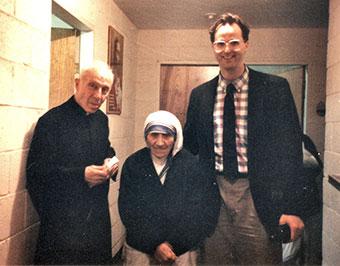 Among the dozens of books authored by Fr. Hardon on the topics of religion and theology, his most defining works include his authorship of The Catholic Catechism (1975). This work stands as a significant contribution to Catholic orthodoxy, written at the request of His Holiness, Pope Paul VI, with whom Fr. Hardon had a close working relationship. Fr. Hardon also wrote the Modern Catholic Dictionary (1980), a detailed Catholic reference dictionary. He served as the executive editor of The Catholic Faith magazine, editor of Gospel Witness, and a contributing editor of Challenge magazine, London and Canada. Fr. Hardon also served as a consultant for the drafting of the Catechism of the Catholic Church, edited by Joseph Cardinal Ratzinger (later Pope Benedict XVI) and promulgated by His Holiness, Pope St. John Paul II in 1992.
Among the dozens of books authored by Fr. Hardon on the topics of religion and theology, his most defining works include his authorship of The Catholic Catechism (1975). This work stands as a significant contribution to Catholic orthodoxy, written at the request of His Holiness, Pope Paul VI, with whom Fr. Hardon had a close working relationship. Fr. Hardon also wrote the Modern Catholic Dictionary (1980), a detailed Catholic reference dictionary. He served as the executive editor of The Catholic Faith magazine, editor of Gospel Witness, and a contributing editor of Challenge magazine, London and Canada. Fr. Hardon also served as a consultant for the drafting of the Catechism of the Catholic Church, edited by Joseph Cardinal Ratzinger (later Pope Benedict XVI) and promulgated by His Holiness, Pope St. John Paul II in 1992.
<< See all of Fr. Hardon’s publications >>
Fr. Hardon’s catechetical mission expanded with the catechetical study program, which he wrote for the Holy See after Pope St. John Paul II requested Mother Teresa to educate her Missionaries of Charity to become catechists. This catechetical course, studied by the Missionaries of Charity worldwide in their formation, has been adapted into home-study courses for the laity, entitled the Manual of the Basic Catechism Course, the Advanced Catechism Course (36 lessons), and the Masters of the Spiritual Life Course. These courses serve as the formation program for the Marian Catechetical Apostolate, founded by Fr. Hardon in 1985 in order to train the laity to become catechists and evangelists in the modern world. This apostolate was directed by Fr. Hardon until his death and is now headed by International Director Cardinal Raymond L. Burke. In 1995, at age 81, Fr. Hardon inaugurated a series of full-semester courses by teleconference, published in albums of twelve audiocassettes on a variety of topics including Angels and Demons, The Blessed Sacrament, The Sacraments and the Marian Catechist, The Spiritual Exercises of St. Ignatius of Loyola, The Profession of the Roman Catholic Faith, Catholic Sexual Morality: A Challenge—A Solution, The Truth Crusades Series I, Series II and Series III and the Ten Commandments. This work in the audio field broadened Fr. Hardon’s ability to reach people with the Gospel message through the use of mass media communications. The importance of the mass media continued to be a force of Fr. Hardon’s teaching and apostolates. Both the Marian Catechists Apostolate and the Fr. John A. Hardon S.J., Media Apostolate (founded posthumously at Fr. Hardon’s request) focus on bringing the faith to the modern world through the means of mass media communication. 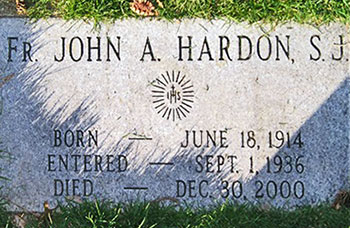 Throughout his life, Fr. Hardon was recognized for his heroic efforts to teach and to preach the truth “in and out of season.” He was the recipient of the Papal Medal in 1951. He was honored for his outstanding work in the field of history by the Catholic Press Association in 1973. In 1978 he received a medal from the Slovak World Congress. In 1984 he received the Cardinal Wright Award from the Fellowship of Catholic Scholars. He was honored with the St. Maximilian Kolbe Award in Mariology in 1990. Fr. Hardon also was a member of the Catholic Truth Society, the Society for Religious Vocations, the International Association of Mission Studies, and the Fellowship of Catholic Scholars. Fr. John Hardon passed into eternity on December 30, 2000 at the Columbiere Jesuit House in Clarkston, Michigan. Efforts are in progress for the creation of a permanent archive and study center on the life and work of Fr. Hardon at the Shrine of Our Lady of Guadalupe, in La Crosse, Wisconsin. The Archive and Guild is temporarily located in Bardstown, Kentucky, and is a work for the cause of the beatification and canonization of the Servant of God, Fr. John Anthony Hardon S.J.
Throughout his life, Fr. Hardon was recognized for his heroic efforts to teach and to preach the truth “in and out of season.” He was the recipient of the Papal Medal in 1951. He was honored for his outstanding work in the field of history by the Catholic Press Association in 1973. In 1978 he received a medal from the Slovak World Congress. In 1984 he received the Cardinal Wright Award from the Fellowship of Catholic Scholars. He was honored with the St. Maximilian Kolbe Award in Mariology in 1990. Fr. Hardon also was a member of the Catholic Truth Society, the Society for Religious Vocations, the International Association of Mission Studies, and the Fellowship of Catholic Scholars. Fr. John Hardon passed into eternity on December 30, 2000 at the Columbiere Jesuit House in Clarkston, Michigan. Efforts are in progress for the creation of a permanent archive and study center on the life and work of Fr. Hardon at the Shrine of Our Lady of Guadalupe, in La Crosse, Wisconsin. The Archive and Guild is temporarily located in Bardstown, Kentucky, and is a work for the cause of the beatification and canonization of the Servant of God, Fr. John Anthony Hardon S.J.
References:
- Fr. John Hardon, S.J., Spiritual Autobiography, Hardon Archive, 6.
- Hardon, SA, 6.
- Hardon, SA, 7.
- Hardon, SA, 19.
- Hardon, SA, 36.
- Hardon, SA, 37.
- Hardon, SA, 37.
- Hardon, SA, 40.
- Hardon, SA, 50.
- Hardon, SA, 57.
- Hardon, SA, 67.
Prayer for Canonization | Publications | Free Prayer Card | Photos

